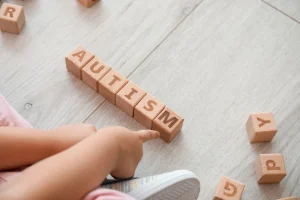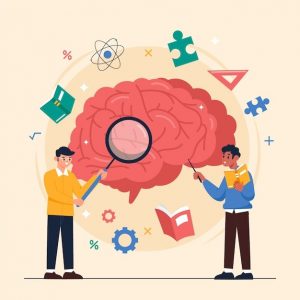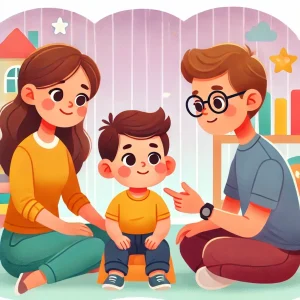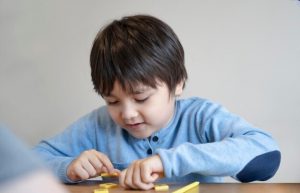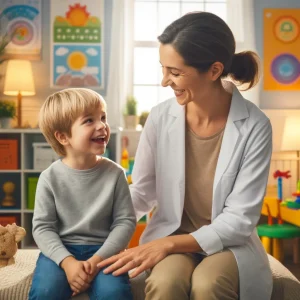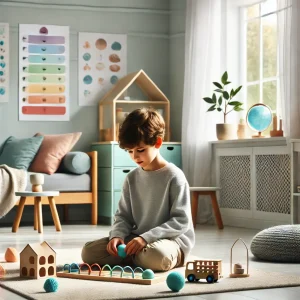Language Development: Stages, Tips, and Common Challenges
By Wellness Hub
Last Updated: November 15, 2024
Language development is how children learn to communicate through sounds, words, and sentences. It starts at birth and continues as they grow. This process is vital for their overall growth, including cognitive, social, and emotional skills.
What is Language Development?
Language development is the ability to understand and use words to express thoughts, needs, and emotions. It involves learning sounds, building vocabulary, and forming sentences.
Why is Language Development Important?
Language skills help children:
- Think and solve problems.
- Build strong social connections.
- Share emotions and needs with others.
These skills shape their ability to succeed in school and life.
Stages and Key Milestones
Children learn language in stages:
- Babbling (0-12 months): Experimenting with sounds.
- First Words (12-18 months): Saying simple words like “mama” or “ball.”
- Word Combinations (18-24 months): Combining words like “want cookie.”
- Sentences (2-3 years): Forming short sentences and asking questions.
- Fluency (3+ years): Using complex sentences and storytelling.
Supporting language development helps children grow into confident communicators. Focus on talking, reading, and listening together daily.
Read More: Enhancing Language Development through Articulation Programs
Stages of Language Development
Overview of Stages
1. Pre-linguistic Stage (Birth to 12 Months)
Babies communicate through crying, cooing, and babbling. They respond to voices and start recognizing familiar words. Parents should talk, sing, and read to encourage language growth.
2. Early Language Development (1-2 Years)
Toddlers say their first words and begin forming simple sentences. Vocabulary grows rapidly. Repeating words and engaging in conversations helps boost their skills.
3. Expanding Language Stage (2-3 Years)
Children use more complex sentences and ask many questions. They learn to express feelings and ideas. Reading books and teaching new words enhance this stage.
4. Advanced Language Skills (3-5 Years and Beyond)
Kids master grammar and storytelling. They enjoy group conversations and follow multi-step directions. Encourage them to describe experiences and explore new topics to strengthen communication.
Factors Influencing Language Development
Key Factors in Language Growth
Language development depends on many factors. These include:
- Genetic predisposition: Some children inherit strong language abilities.
- Environmental exposure: Interaction with parents and caregivers boosts language skills. Socioeconomic factors can also play a role.
- Nutrition and health: Proper nutrition and good health are vital for brain development.
How Environment Shapes Early Language Skills
A rich environment promotes strong language growth. Talking, reading, and singing with children helps them learn words and phrases. Children surrounded by language grow their vocabulary faster.
The Role of Play and Social Interaction
Play encourages communication. Social games like pretend play or role-playing teach children how to express thoughts and emotions. Simple conversations during play build language skills naturally.
Activities and Strategies to Enhance Language Development
Practical Tips for Parents and Caregivers
Boost your child’s language skills with these simple, effective activities:
- Read Aloud and Tell Stories: Share books and stories every day. Reading builds vocabulary and sparks imagination.
- Use Flashcards and Educational Games: Flashcards teach new words and improve memory. Games make learning fun and interactive.
- Encourage Daily Conversations: Talk with your child about their day. Ask open-ended questions to expand their communication skills.
These strategies create strong language foundations while making learning enjoyable. Start today!
Read More: Speech Development Milestones: Your Child’s Talking Journey
Language Development in Diverse Contexts
Supporting Bilingual Language Learners
Help your child thrive in a bilingual environment. Learn strategies to build vocabulary in both languages. Encourage everyday conversations to strengthen language skills.
Understanding and Addressing Speech Delays
Early intervention makes a big difference. Identify common signs of speech delays in children. Use interactive tools to support language development at home.
Unique Needs of Children with Autism or Developmental Challenges
Every child learns differently. Discover tailored techniques for children with autism. Build communication skills with engaging, sensory-friendly resources.
Empower your child’s language journey today!
Common Challenges and How to Address Them
1. Identifying Signs of Language Delay
Parents often struggle to recognize early signs of language delays. Look for missed developmental milestones, like not saying single words by 12 months or forming simple sentences by age two. Use tools like flashcards to encourage vocabulary growth and communication.
2. Overcoming Cultural and Environmental Barriers
Children may face challenges due to bilingual homes or limited exposure to language-rich environments. Incorporate diverse flashcards to introduce new words and concepts, bridging the gap between different languages or cultures.
3. Navigating Speech Therapy and Professional Intervention
Knowing when to seek help can be hard. If you notice persistent struggles with communication, consult a speech therapist. Flashcards can support therapy by offering practice in a fun and engaging way.
The Science Behind Language Development
How the Brain Builds Language Skills
The brain plays a vital role in language development. Different areas work together to process sounds, form words, and create sentences. These areas include the Broca’s area for speech production and Wernicke’s area for understanding. Healthy brain connections help children grasp language quickly.
Why Critical Periods Matter
Critical periods are windows of opportunity when the brain absorbs language the fastest. These stages occur in early childhood, making ages 0-6 crucial for language learning. Providing rich exposure during this time helps kids develop strong communication skills.
Neuroplasticity and Language Growth
The brain’s neuroplasticity allows it to adapt and grow. This means kids can still improve their language skills, even after delays. Interactive activities, like flashcards and conversations, strengthen these connections and boost progress.
Support your child’s language journey today with engaging resources. Explore our flashcards now!
Conclusion
Nurturing language development is key to helping children grow and succeed. As parents and caregivers, your role is essential in building a strong foundation for communication skills. Explore our related articles to learn more about language milestones, fun activities, and expert tips. Dive deeper into how you can support your child’s learning journey with simple and engaging techniques.
Frequently Asked Questions
1. What is language development?
Language development is the process where children learn to understand and use words, phrases, and sentences to communicate. It starts at birth and continues as they grow.
2. When do babies start talking?
Most babies say their first words around 12 months. Before that, they communicate with sounds, gestures, and babbling.
3. How can I encourage language development?
Talk to your child daily, read books, sing songs, and describe your actions. The more you interact, the more they learn.
4. What are speech milestones by age?
- 12 months: First words
- 2 years: Combining two words (e.g., “want toy”)
- 3 years: Speaking in short sentences
- 4 years: Clear speech with larger vocabulary
5. Why is my child not talking yet?
Every child develops at their own pace. However, if your child shows no signs of communication by 18 months, consult a pediatrician or speech therapist.
6. Are flashcards helpful for language development?
Yes! Flashcards introduce new words, build vocabulary, and make learning fun. They are great for interactive play with your child.
7. Can screen time impact language skills?
Too much screen time can limit real-world interaction, which is crucial for language development. Balance screen use with face-to-face communication.
8. How does bilingualism affect language development?
Children can learn multiple languages simultaneously. They may take longer to use each language but will eventually become fluent in both.
9. What are signs of a speech delay?
Limited vocabulary for their age
- Difficulty forming sentences
- Not responding to their name or following simple directions
10. When should I seek professional help?
Consult a speech-language pathologist if your child isn’t meeting milestones or shows frustration with communication.
About the Author:
Rajini Darugupally
M.Sc., Speech-Language Pathologist (9+ years of experience)
Rajini is a passionate and dedicated Speech-Language Pathologist with over 9+ years of experience, specializing in both developmental speech and language disorders in children and rehabilitation in adults. Currently, at Wellness Hub, she thrives in a team environment that values innovation, compassion, and achieving results for their clients.
Book your Free Consultation Today
Parent/Caregiver Info:
Client’s Details:
* Error Message
